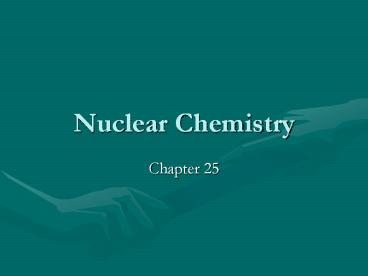Nuclear%20Chemistry PowerPoint PPT Presentation
Title: Nuclear%20Chemistry
1
Nuclear Chemistry
- Chapter 25
2
Learning Objectives
- Students will understand
- The criteria for nuclear stability and the
processes by which unstable nuclides decay - Issues of safety and health with respect to
radioactivity - Uses of radioactive isotopes in science and
medicine
3
Learning Objectives
- Students will be able to
- Write equations for the decay of radioactive
elements and the synthesis of new isotopes - Carry out calculations based on equations for the
first-order rate of decomposition of unstable
isotopes
4
25.1 Natural Radioactivity
- occurs when a nucleus undergoes decomposition to
form a different nucleus and additional particles - when a radioactive particle is stopped by a
material, or when radiation is absorbed, the
energy associated with the radiation is
transferred to the material - damage caused by radiation is related to the
energy absorbed
5
Alpha Radiation
- An alpha particle, a particle, is a helium
nucleus 4He - Least penetrating, can be stopped by several
sheets of ordinary paper or clothing - Heavy radioactive nuclides, isotopes, undergo
decay to form alpha particles.
6
Practice Problem
- Write a balanced equation for the decay of
uranium-235 by a-particle production.
7
Beta Radiation
- A beta particle, ß particle, is an electron
represented in a nuclear reaction by the symbol
0-1e - The beta particle has a mass number 0. Its mass
is very small - Can penetrate several millimeters of living bone
or tissue, but about 0.5 cm of lead will stop the
particles
8
Gamma-Ray Production
- A gamma ray, ?, is a high-energy photon often
produced during nuclear decay. - Gamma rays are unaffected by electric and
magnetic fields. - The most penetrating and can pass completely
through the human body, thick layers of lead or
concrete are required to shield the body - A nucleus with excess energy can relax to its
ground state by emitting a gamma ray - 235U ? 4He 231Th 0?
9
25.2 Nuclear Reactions and Radioactive Decay
- Nuclear reactions occur when an isotope of one
element changes into an isotope of a different
element.
10
Practice Problem
- Six aand four ßparticles are emitted in the
thorium-232 radioactive decay series before a
stable isotope is reached. The first three steps
are a, ß, ßemission. What is the final product
in this series?
11
Other Types of Decay
- A positron is an emitted particle which has the
same mass as an electron but opposite charge.
(antimatter to an electron) - results in a decrease in the atomic number
- Electron capture occurs when a nucleus captures
an inner orbital electron. - 7Be 0e ? 7Li
12
Practice Problems
- Write a balanced equation for the decay of
carbon-14 by ß-particle production. - Write a balanced equation for the decay of
bismuth-205 by positron production.
13
Name Symbols Charge Mass (g/particle)
Alpha 4He, 4a 2 6.65 x 10-24
Beta 0-1e, 0-1ß -1 9.11 x 10-28
Gamma ? 0 0
14
25.4 Rates of Nuclear Decay
- Half Life is the time required for half of the
sample to decay to products (independent of the
amount of sample for first-order decomposition) - t1/2 0.693/k
15
Practice Problem
- Tritium (3H), has a half-life of 12.3 years.
- Starting with 1.5 mg of this isotope, what mass
(mg) remains after 49.2 years? - How long will it take for a sample of tritium to
decay to one eighth of its activity? - Estimate the length of time necessary for the
sample to decay to 1 of its original activity.
16
Practice Problem
- A sample of Ca3(PO4)2 containing phosphorus-32
has an activity of 3.35 x 103 dpm. Exactly 2
days later, the activity if 3.18 x 103 dpm.
Calculate the half-life of phosphorus-32.
17
Homework
- After reading sections 25.1 25.2 25.4 you
should be able to do the following - P. 1007a-b (1-15 odd, 29, 31)

